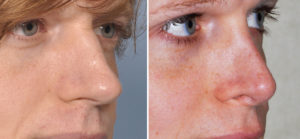Facial feminization surgery changes the structure of the male face to appear more feminine. While procedures from the skull down to the trachea exist to make these modifications, nose reshaping is one of the mainstay operations. That is not only because it sits in the middle of the face but because it has distinct gender differences.
In the December issue of the journal JAMA Facial Plastic Surgery, an article entitled ‘Technical and Clinical Considerations for Facial Feminization Surgery With Rhinoplasty and Related Procedures’ was published. In this paper the authors reported on the role of rhinoplasty and other facial procedures procedures to feminize the nose to the forehead and lower face. A series of 200 consecutive male-to-female transgender patients were objectively evaluated. Frontonasal angles were measured as well as assessment by a five point nose feminization scale. In these 200 patients the mean frontonasal angle increased by a difference of 15 degrees from an average 133 degrees to an average 149 degrees. Patients considered their nose more feminine with a high satisfaction level. (4 out of 5 on the Nose Feminization Scale)
The authors also discussed how a feminizing rhinoplasty was also seen to be enhanced by changing adjacent facial structures as well with inferior lip lifts and superior brow bone reductions and forehead reshaping.

The difference between the male and female nose is more than just size alone. The female nose shape is more narrow, the tip is more refined and upturned (increased nasolabial angle) and the nostrils are smaller. In addition the frontonasal angle is larger and this is helped to be achieved by the effect of brow bone reduction above the radix of the nose to soften this angle. This frontonasal angle change is a critical element in a feminizing rhinoplasty.
In conjunction with forehead reshaping, the refinement of the nose can significantly improve facial gender transition. A rhinoplasty contributes significantly to making the face appear softer and more feminine.
Dr. Barry Eppley
Indianapolis, Indiana


